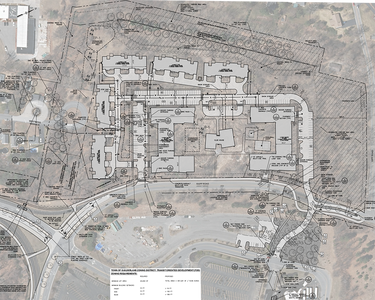New owners seek to tweak plan for 222-unit Apex at Crossgates
GUILDERLAND — The first of two public hearings was recently held on a 222-unit development proposal to be built on land recently owned by Crossgates Mall.
Speakers at the July 13 hearing broadly fell into two categories, with the exception of one resident who noted the project had been scrutinized six ways from Sunday: Westmere Terrace residents advocating on behalf of their neighborhood and members of Save the Pine Bush looking to protect the globally rare inland pine barrens.
Westmere Terrace residents and Save the Pine Bush had each independently and unsuccessfully sued to stop the Pyramid project.
The next public hearing is scheduled for Aug. 10.
Previously known as the Pyramid Companies’ Rapp Road residential project, the 222-unit proposal — 192 apartments and 30 townhomes — has been branded by its new owner, the United Group of Companies out of Troy, as The Apex at Crossgates.
The developer bought the nearly 20-acre parcel from Crossgates for $5.43 million in June, and was before the Guilderland Planning Board on Wednesday seeking an amendment to Pyramid’s already-approved site plan.
The Pyramid plan, which received town approval in October 2020, proposed three two-story townhouse-style buildings, with 10 units in each building, totaling 30 units, on the west side of the parcel, or rear of the property running parallel to Rapp Road. Pyramid then proposed two five-story L-shaped apartment buildings, one with 94 units and the other with 98 units, on either side of the two entrances near the front of the development.
United Group’s proposal is to shift the two five-story buildings approximately 300 feet to the north, away from Westmere Terrace. The new project also proposes more spacing out of the development.
The project narrative submitted to the town states the “222 residential units will remain consistent with the previously approved site plan,” but it’s also “noted that with this plan that the additional 90 units, designated as future development, will be permanently abandoned.”
Jeff Smetana, the United Group’s executive vice president for development, told the planning board the company is also abandoning plans for 4,300 square feet of commercial space to reduce traffic, which had been one of the issues touched on by a few of the speakers.
Westmere
Tom Hart, a Westmere Terrace resident and a plaintiff in one of the two lawsuits that held up the project for nearly two years, was one of the first to voice his concern.
“I appreciate the position that you are in,” he said, but “one of the things that seems to be just put aside, that everybody is just accepting [as] fact [is] ... traffic is not going to increase at all. There’s not going to be any impact of increased traffic whatsoever.”
He continued, “I ask any one of you to come over on Westmere Terrace at any point during the day, all right? And try to take a left-hand turn off for Westmere Terrace. It’s near impossible.”
Hart was concerned about the way he and his neighbors exit Westmere Terrace. “And the solution that the town come up with and Pyramid come up with was to open up the end of Westmere Terrace,” he said.
Town planner Kenneth Kovalchik explained to The Enterprise through email that the “issue of Westmere Terrace residents having difficulty making left turns out of Westmere Terrace to Western Avenue can be traced back to 1994,” which was the year the mall expanded, nearly doubling in size.
In 1994, Kovalchik said, the state’s Department of Transportation recommended a one-way exit from the Westmere Terrace cul-de-sac to Rapp Road. “The residents of Westmere Terrace did not support this proposal dating back to 1994,” he wrote.
“During the preparation of the Environmental Impact Statement the Town/Pyramid offered two options to the residents of Westmere Terrace to address the difficulty in making a left turn to Western Avenue …
“One option was similar to what DOT proposed in 1994, which was to offer a one way exit from the cul-de-sac to Rapp Road. A second option was to connect the cul-de-sac to the proposed parking lot of the 222 unit multi-family residence proposed off of Rapp Road, which would have allowed them access to Rapp Road. The residents of Westmere Terrace rejected both options.”
On July 13, Westmere Terrace resident Iris Broyde first echoed the sentiment many of her neighbors offered: She thanked the United Group for moving the development further away from the neighborhood.
But then Broyde sought assurances from the planning board about the future of her Westmere Terrace neighborhood.
When Crossgates expanded in 1994, Broyde said, “The zoning board recognized the vulnerability of the Westmere Terrace neighborhood due to our proximity and established this condition of a guarantee to a cul-de-sac to protect us from developmental encroachment and preserve our character as a private street.”
Broyde went on, “Without the established guarantee of a cul-de-sac legally in place, what is now being constructed as a new cul-de-sac can foreseeably become anything.”
Smetana, of the United Group, said earlier in the meeting, that one of the most significant site improvements the company will be making is relocating the Westmere Terrace cul-de-sac “south a little bit.”
Referencing the project’s environmental impact statement, Broyde said, “Let me remind the board that the approved EIS states as two options of its mitigating strategies for the deteriorating traffic conditions that will befall Westmere Terrace, access routes from the cul-de-sac onto Rapp Road theoretically for residents of Westmere Terrace only.”
According to Broyde, a representative from Pyramid gave his verbal assurance that the access-route option was only included to satisfy mitigation criteria for the EIS, and that the option would not be exercised. “And with the cul-de-sac guarantee in place, that would probably be true,” she said.
“Creating an access route would violate the very definition and intended purpose of the cul-de-sac. With that protection gone, not only could the cul-de-sac become a resident access road, it could become a thoroughfare for public use,” Broyde said. “Both uses that have been vehemently contested by residents for decades and was supported by the ZBA by committing to the protection in writing.”
Broyde said it was imperative for the preservation of the existing neighborhood that the “unconditional guarantee of a cul-de-sac at the end of Westmere Terrace remain in place and be instituted as a condition of approval for the Apex at Crossgates amended site plan.”
Environment
A half-dozen Save the Pine Bush volunteers spoke in general terms about the worth of the globally rare pine barrens, asking the planning board to kibosh the entire proposal.
But Donald Csaposs, the chief executive officer of Guilderland’s Industrial Development Agency and the town’s grant writer, who made it clear he was speaking strictly as a private citizen during the July 13 public hearing, asked the planning board to think about all the environmental review the project had already been through.
“I’ve sat here and listened to comments related to the environment. And I’m not here to make a recommendation on how you should proceed with this application,” he said. “But I’d like to comment on the appropriate process for the board to follow.”
Csaposs said, “In the case of an application relative to a property that’s within the Albany Pine Bush Preserve management study area,” the New York State legislature created the Pine Bush Preserve Commission over 30 years ago and tasked it with maintaining a viable preserve.
Csaposs said the application, in its original iteration, was subject to review by the Pine Bush Preserve’s Commission’s Technical Committee, which consists of representatives from the state’s Department of Environmental Conservation and Office of Parks, Recreation and Historic Preservation as well as the commission staff.
“I’d point out that the staff of the Pine Bush Preserve Commission are highly educated and competent environmental scientists, many of whom have devoted all or nearly all of their professional careers to the task of establishing and maintaining a viable Pine Bush Preserve,” Csaposs said.
“To date,” he said, the technical committee provided comments on the 222-unit project on at least five occasions: “With regard to the first iteration of this project in January of 2019, review of the site plan application. In April 2019, review of the proposed mitigation. And October 2019, review of the proposed Rapp Road bypass options. And in March 2020, the review of the draft environmental impact statement for the Rapp Road residential development project. The technical committee also reviewed the proposed amendment.”



